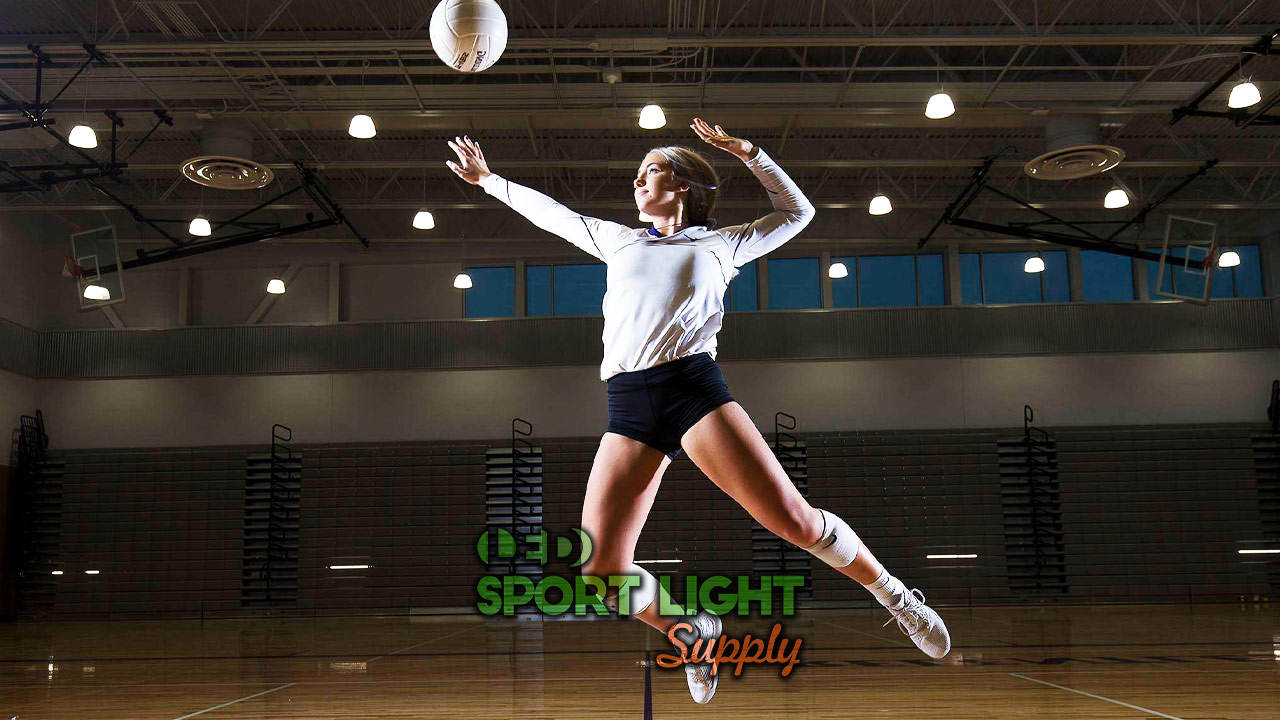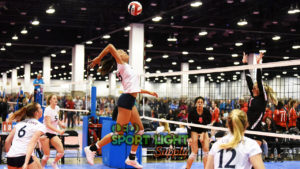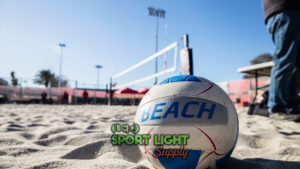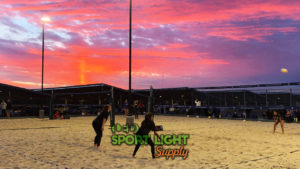Volleyball court lighting standards
1. Lux and footcandle standard of volleyball court lights
Team sports, such as volleyball, require precise light levels for optimal players’ performances. In the International System of Units, lux represents the standard unit of measurement. But the American volleyball court, foot-candles (fc) are an alternative unit as well. Just remember that 1 fc equals 10.76 lux. Below is each lighting requirement briefly explained to help you familiarize yourself with your regulation needs.
a) Training: 200 to 400 lux (19 to 37 fc)
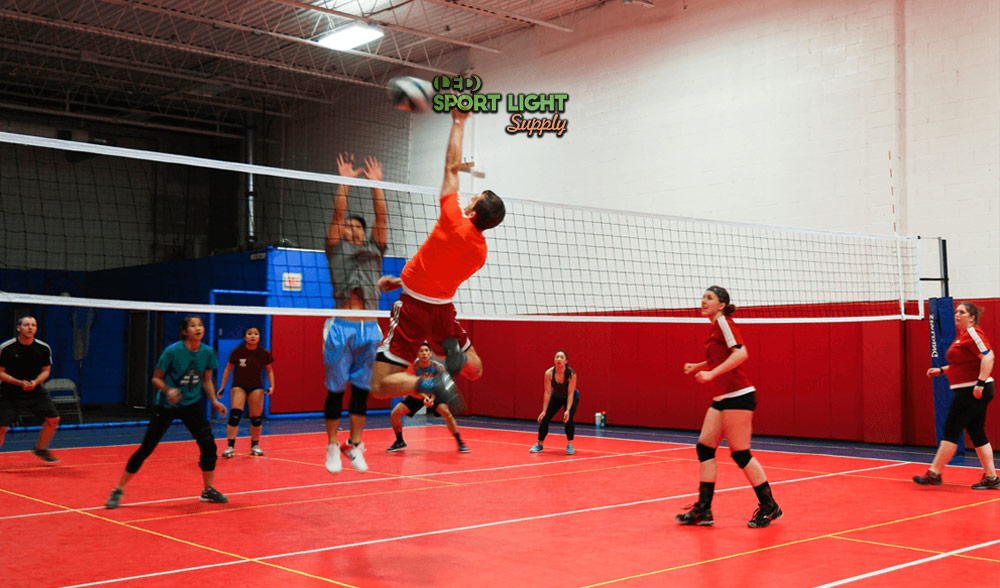
No matter what the team’s level of play is, training is a constant. As such, the illumination system must provide an adequate lux level of at least 200 lux. Beginners volleyball players learn basic skills such as how to serve, pass, attack, and block. Instead, pro athletes must work on concentration and teamwork. After all, the lighting design for training should help attackers to bring the heat with every spike. As well as facilitating blockers to eliminate reception errors.
b) High school, college, or local competition: 500 lux (46 fc)
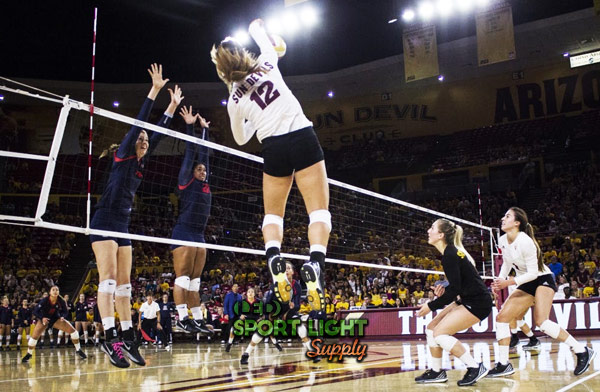 During high school or college competitions, the lighting standard should rise to 500 lux. The requirement is slightly higher than the training standard. Mostly because it fits the young players’ desire to win. In the volleyball court, it is always good to provide enough brightness to avoid accidental collisions. Then again, each player might have some rough edges still. Accepting one’s frailties requires a lot of courage. Plus, participating in competitions is the only way to overcome these limits.
During high school or college competitions, the lighting standard should rise to 500 lux. The requirement is slightly higher than the training standard. Mostly because it fits the young players’ desire to win. In the volleyball court, it is always good to provide enough brightness to avoid accidental collisions. Then again, each player might have some rough edges still. Accepting one’s frailties requires a lot of courage. Plus, participating in competitions is the only way to overcome these limits.
c) Regional broadcast: 800 lux (74 fc)
When broadcasters get involved, you can be sure that the lighting level is higher than normal. The volleyball facility owner must deal with a precise lighting regulation. In fact, video cameras need higher light levels to broadcast effectively. The higher standard lets the broadcaster to stream enhanced contrasts. Plus, it makes the players on the volleyball court and the coach look more lively. More brightness means the viewers can savor each jump set and back row attack! It just makes the match more exciting to watch.
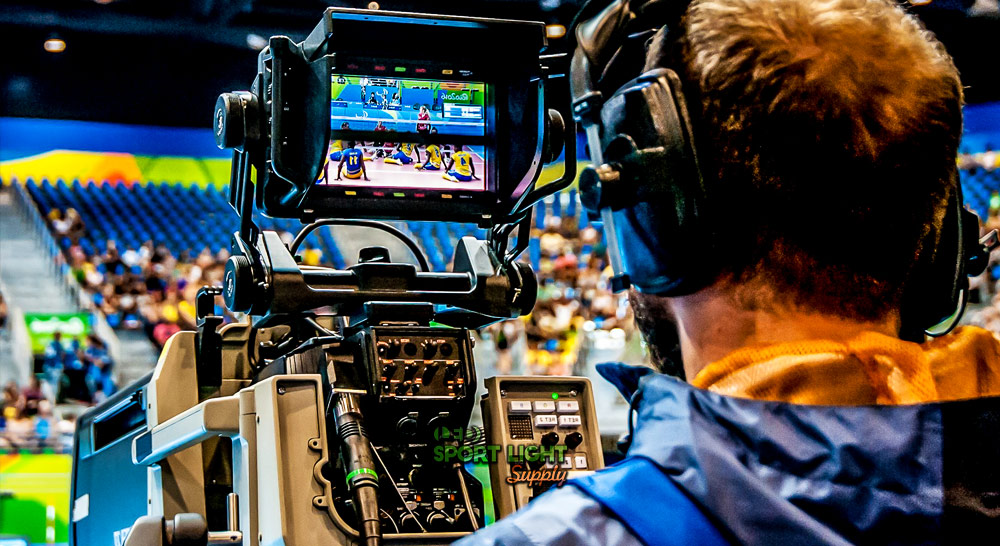
d) National broadcast: 1,000 lux (93 fc)
Top tier volleyball clubs access the national league. So, the lighting layout must provide top-notch illuminance. For both the players, spectators, and broadcasters, of course. To be precise, the usual requirement of 1,000 lux or 93 fc could undergo minor changes. That is, according to the federation or association. Sometimes, for national tournaments, a special regulation is approved. In that case, reading the released guidelines will reveal the adopted standard for the quarters or final.
e) National Championship, such as Olympic Games, NCAA: 1,500 lux (140 fc)
As you can imagine, elite players and teams dispute their matches in the most renowned venues. In particular, the lighting standard soars to 1,500 lux to reach the best conditions for streaming these events all over the world. Whoever watches these competitions will enjoy the most realistic colors and outlined shapes. In this case, all the best features and products are at play to give the viewer the joy of every scored point.
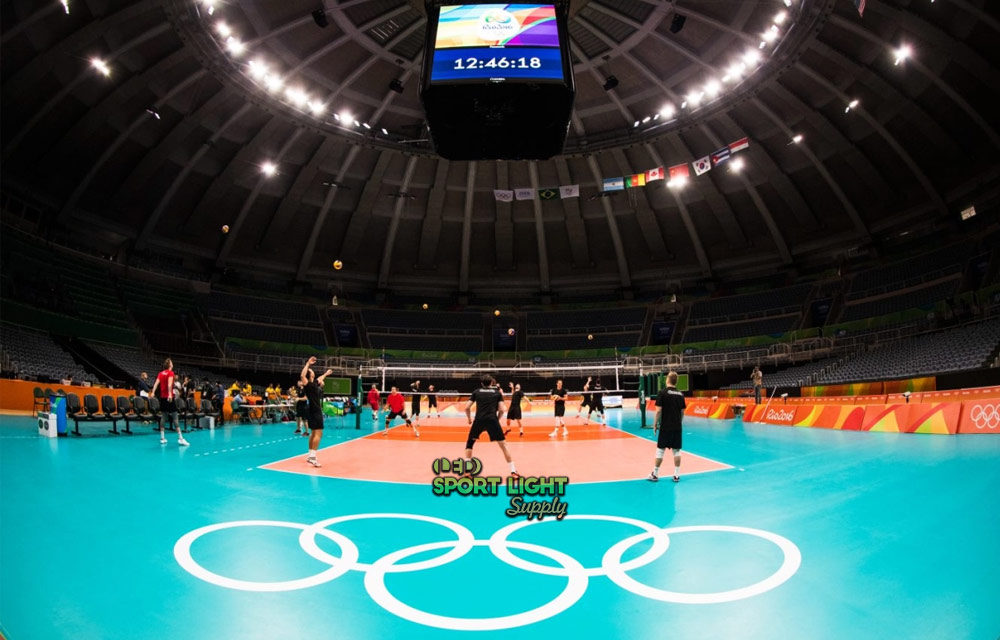
2. Lighting uniformity requirement
Light distribution is also a relevant factor to create uniform illumination. In the volleyball court, an evenly illuminated pitch lets players bring out their team play. Just imagine doing a quick set but stepping into a different, brighter area all of a sudden. If the distribution is not on par with the standard, the attacker cannot sustain his or her focus. To calculate the lighting uniformity, several lux samples are required. After finding the max and min values, divide the min by the max lux reading. Compare that number with the requested value.
a) Training: 0.4 to 0.5
A standard volleyball training session includes tactics and strategies. For example, an offensive system with tweaked moves to score a set point. This requirement is suitable for both recreative and competitive training methods. In fact, it gives middle hitters enough dispersed light to move smoothly forward and back. And blockers can practice digging without any distraction as well. Then again, the higher range is more suitable for advanced tactics such as shoot, tandem, and double-quick sets.
b) High school, college or local competition: 0.5
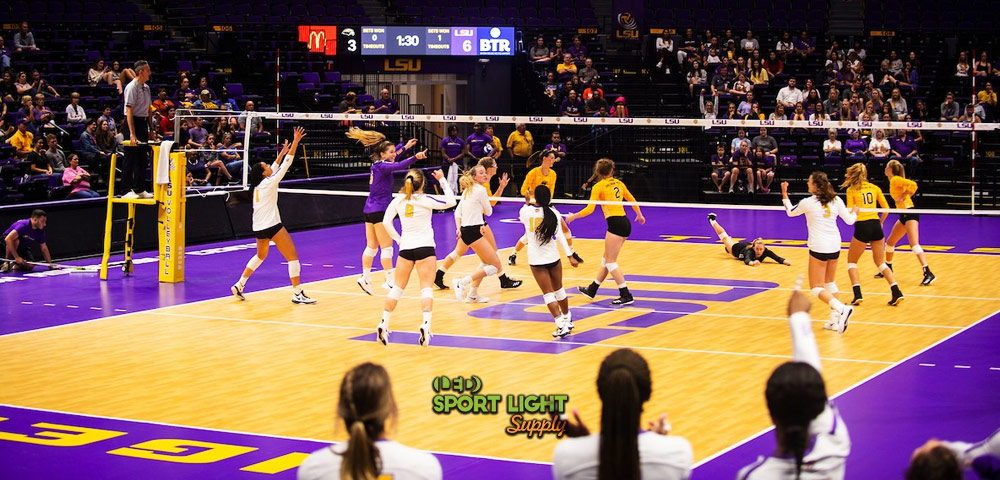
The high school lighting standard for sports activities like volleyball is 0.5. In detail, this means that your local competitions must happen under an evenly distributed light to ensure that players’ safety. More importantly, this value indicates that you should use a lux meter to achieve optimal light intensity. On the volleyball court, professional equipment should give you precise readings for possible calibration. See your association’s regulation for more details.
c) Regional broadcast: 0.6
A higher lighting uniformity standard allows regional broadcasters to record clear pictures. More intense light sources eliminate any ill-lit area. For the players, the light remains diffused. They might notice enhanced color contrasts of the volleyball court borders. Another vital detail is the installation of flicker-free floodlights. As you will read later, the high-power lights should also come with this feature to allow for crystal clear streamings. Otherwise, the viewers might change the channel.
d) National broadcast: 0.6 to 0.7
National volleyball teams play with many spectators in the stands cheering for them. So, the lighting system usually involves spotlights to provide an extra glow. Just imagine a climactic exchange. The volleyball court almost shines as it fixes the spectators’ attention on the stuff. Then, the attacker jumps and tools the block with a swipe against the redwood. Without enough uniform lighting, the superior team skill level could not entice the audience. Besides, it would be hard to sell more tickets every single time.
e) National Championship, such as Olympic Games, NCAA: >0.7
From a technical point of view, high light uniformity reduces shady parts of the volleyball court. Thanks to indoor and outdoor fixtures, the light beam can be evenly distributed with both broad or narrow luminous fluxes. What really matters is the overall lighting layout. For this reason, national championships follow a strict lighting regulation. During the Olympic Games, a lack of professional design could look like a political affront.
3. Color temperature
LED lights are the most versatile light sources because they can let you choose how the light looks like. If you are familiar with the Kelvin temperature scale, most LEDs are available between the 3,000 and 7,500 K range. A Kelvin is a unit of measurement that allows us to describe the color of luminous flux. Low K values equal to more yellowish colors. Instead, the opposite higher values tend more to a bluish hue.
For the volleyball court, you should consider using:
- standard warm white or cool white for recreational (around 5,000K or slightly less)
- cool white >5000K for competitions
4. Anti-glare requirement
Perhaps, the design of lighting scenarios in the volleyball court is one of the most difficult areas to deal with. Mostly because the maintenance factor takes hold with every change. Plus, you must ensure that the players’ psycho-physical conditions are best preserved. In short, anti-glare measures are a must. Especially to make the playing area and nearby stands a more comfortable and safer place. Generally speaking, you need a GR rating <50 to illuminate the volleyball facility. So, consider hiring professionals like us. We give you precise glare rating calculation fast by using DIALux software.
5. Flicker-free requirement
Broadcasters apply several video editing techniques, but live events can suffer from flickering. Flicker-free lights are necessary, especially for slow motion cameras. When a setter puts the ball in the air for the outside hitter to spike it hard, the chances of scoring a point get higher. So, the camera crew points their slow-motion video cameras during these moments. With standard LED lights, a strobe light-like effect would show up. Flickering affects both recordings and live streaming.
6. Light spill (light pollution)
For outdoor volleyball courts, the lux level surrounding the volleyball court should be below 20 lux (5 meters outside the volleyball court). In fact, too bright lights might cause light pollution.
Shielding can reduce the dangers related to the light spill. Besides, the positioning of the flood lights and the vertical angle can have a huge impact. Sometimes, adding extra fixtures can be an option as valid as removing too bright light sources.
Importance of meeting the lighting requirement of the volleyball court
1. A better vision for volleyball players and referee
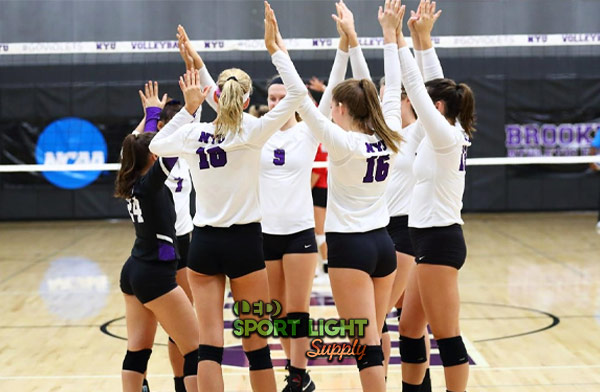 With a prince or princess of whales on the volleyball court, the referee can have a hard time. Each lighting standard takes into account all the people present during the competition. So, this is why the lux level rises as the competitive level increase. Even a simple roof can cause the ball to immediately bounce to the floor. And good contrast and light distribution help the referees to come to a conclusion. Just as much as it allows attackers or blockers to hit the ball correctly.
With a prince or princess of whales on the volleyball court, the referee can have a hard time. Each lighting standard takes into account all the people present during the competition. So, this is why the lux level rises as the competitive level increase. Even a simple roof can cause the ball to immediately bounce to the floor. And good contrast and light distribution help the referees to come to a conclusion. Just as much as it allows attackers or blockers to hit the ball correctly.
2. Create an atmosphere for spectators
When the lighting designers follow the regulation to the letter, the arena becomes spectacular. The volleyball court becomes a splendid battleground. In fact, each team plays into a 9m × 18m (29.5ft × 59.1ft) pitch. The volleyball players must exhibit a synchronized formation and make use of every player’s specialization. Truth be told, volleyball is a sport that lends itself to quick and intense action. Every ace creates gasps in the audience because it all happens so suddenly. This is what fulfilling the lighting requirement is all about.
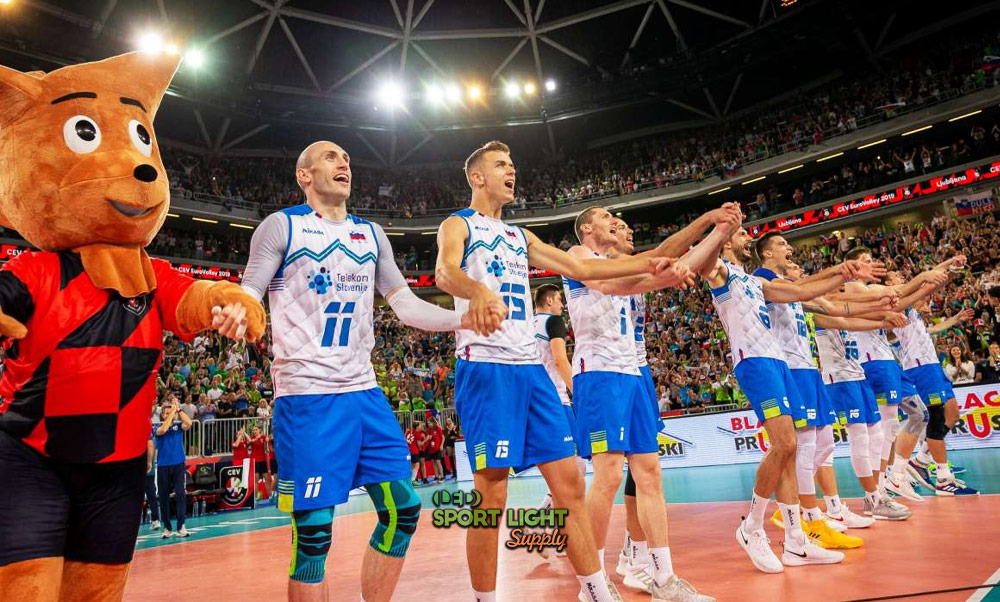
3. Shadowless and flicker-free lighting for TV or broadcasting events
The right light intensity on the volleyball court attracts spectators. Likewise, shadowless and flicker-free lighting for TV and live streaming generates viewers. High-quality LED lights and handling the lighting standard wisely is just a winning combination. Every shot is better, and everyone can enjoy even the little details. But if you do not follow the regulation, who knows what the end results will be. Moreover, it can get some sports facilities or clubs disqualified.
4. Better ad placing
Volleyball facilities owners might like sponsorships as much as clubs do. But if you do not have a well-lit volleyball court, the light will not put the ads on display. When a volleyball match airs on live TV, the ads fulfill their goal. They reach potential customers or drive more traffic to new services and websites. Today, overlooking the importance of the lighting design is just a bad idea. A lack of advertisers’ interest can cost you a great deal of money.

